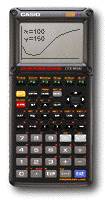|
|
Casio data logger
As seen on
|
AWARD
- This design has been judged the "best overall"
at the Circuit Cellar Ink "Design 98" Contest sponsored
by Microchip and Hewlett Packard.
|
|
Bring the REAL world inside the Casio!
Now you can interface
your Casio to the outside world! Get lots of data from any kind of sensor,
store it in Casio memory, graph it on the built in display in real time or
apply any math function you like.
Do it anywhere,
the unit works on batteries. Sophisticated processing, as regression or statistical
analysis, are only a keystroke away. You can zoom, pan. list your data, or
even transfer it to a PC.
|
V N °C kgm A Hz lux hPa kWh %RH DP |
+
|
|
| your real world sensors... | ...and the casio analog interface... | ...means your data easily graphed and analyzed |
The calculator is left untouched, just connect the analog interface to the "program-link" plug on your Casio and start capturing data.
Tech facts:
> reads up to 8 analog inputs at once
> 1 mV resolution, input range from 0 to 4096 mV (12
bits)
> interfaces directly to a huge vaiety of sensors
> battery operated, >200 hour operation from a single
9V battery
> easy programming through the Receive(X) Casio instruction
> easy to build, uses the popular PIC16C84 (16F84)
> fits in a small plastic box as large as the calculator
<> compatible with Casio FX9750 and
FX9850, CFX9850
Files available:
full
article from circuit cellar ink, issue 99, october 1998
The article covers all the technical details. It includes the schematic
and parts list in case you would build one by yourself.
It also explains the Casio serial protocol and how to make a thermomether
from a temperature sensor.
from the Circuit Cellar web site
HTML on-line version of the same article published by EDTN network
click
here to see the complete circuit diagram
same as in the article above (xy_schem.gif, 52kB<)
the
PIC16C84 (PIC16F84) XYLOG.zip source code
Fully commented, in official Microchip mnemonics. You need the
MPASM assembler (free from www.microchip.com)
to assemble it.
( slow ftp:// access - please be patient)
the PIC16C84(PIC16F84) executable only
errata
- please note:
the schematics erroneously connect the led to the positive supply rail, connect
it to the negative rail instead. Thanks to mr. Mark Pepper for discovering
it.
Compatibility & call for testers:
I built the interface to work with a Casio FX9750. Thanks to
mr. Paul Denham that succesfully tested it on its color CFX9850.
It should work unmodified with similar models (e.g. CFX9800) but I have not
tested it. If you have tested it on any new model, please e-mail me. Thanks.
The Casio is immensely popular in schools. In the classroom, this cheap design lets the Casio capturing data from all kind of experiments. It can make learning physics, math, natural sciences more fun - and more effective. The possibilities are endless - let's look at a few examples


 =
=

